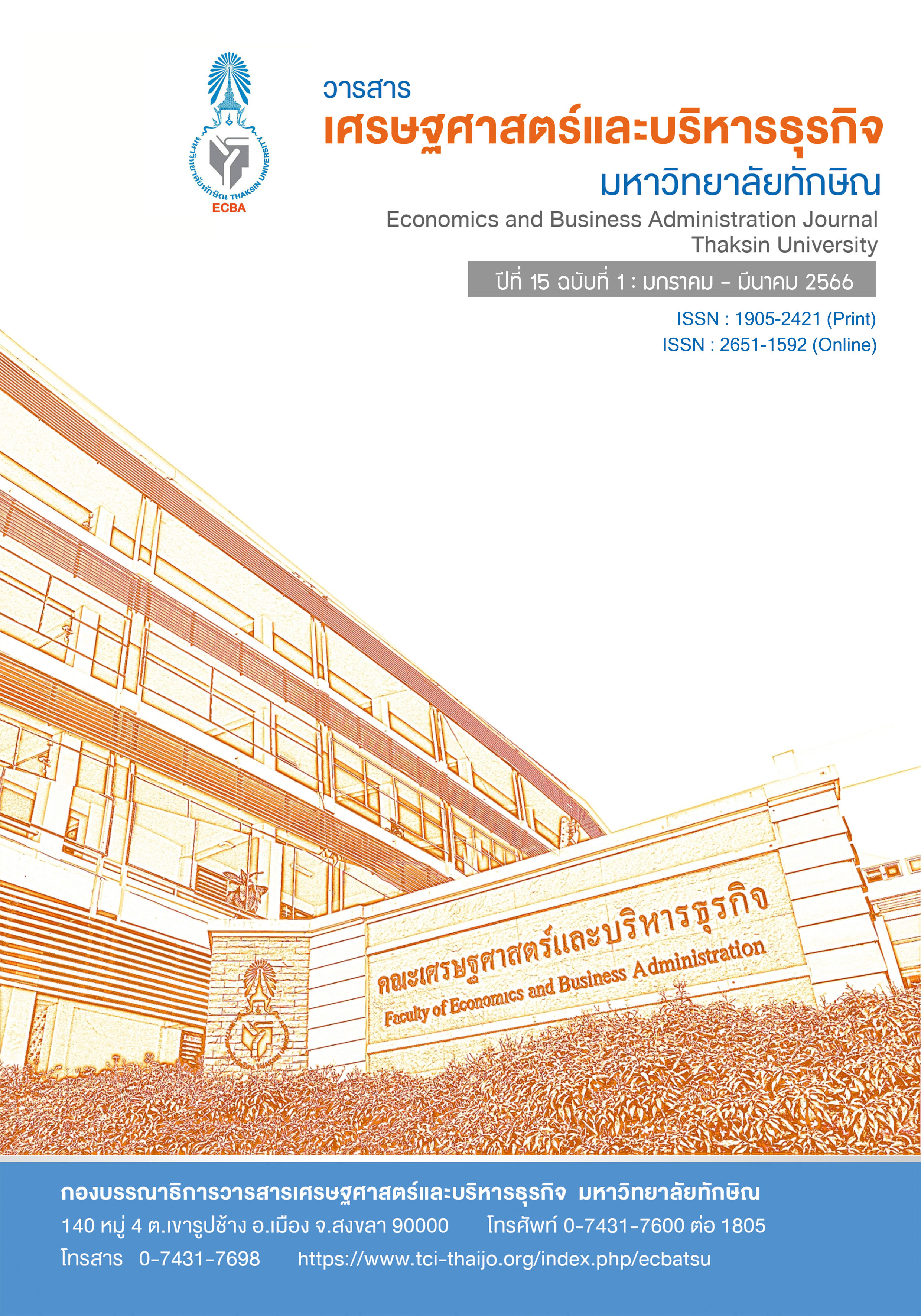The Study of Community Identity for Develop Tourism in Yala Province
DOI:
https://doi.org/10.55164/ecbajournal.v15i1.253000Keywords:
Community Identity, Tourism Development, YalaAbstract
The objectives of this research were: 1) to study the patterns of natural identity, culture, and wisdom, and architecture; and 2) to increase the value of community-based tourism as an identity. The target groups for this research were three communities in Yala Province: 1) Ban Na Tham Community, Na Tham Sub-district; 2) Ban Chulabhorn Phatthana 9 Community, Mae Wad Sub-district; and 3) Asong Community, Asong Subdistrict. Participation action research in finding community identity for tourism development in Yala Province used interviews and small group discussions with key figures from three communities in Yala provincial government agencies, private sectors, tour operators and related academics. An interview form was used to analyze urgent issues of the community, and small group discussions were utilized to find community identity patterns. Then the study proceeded to increase the value of community-based tourism. The results found that 1) the Ban Na Tham community wanted an identity that shows a story connected with Wat Khuha Phimuk, known for its dark cave. With the Ban Na Tham Community, it was decided that a travel map should be prepared for exploring the dark cave, and that the admission rate should be determined according to the distance explored, namely a short distance option of 100 meters, a medium distance option at 400 meters, and the longest at 800 meters. 2) The Ban Chulabhorn Phatthana 9 Community desired an identity that represents stories, ways of life, and dress that maintains traditions, but to also create a new selling point, namely around the Malaya Communist Costume Show. The Chulabhorn Phatthana 9 community proceeded to add a communist Malaya show set and a medicine in tourism program. A rental service for photo shoots was introduced, and new souvenirs on sale, namely communist Malaya hats. and 3) The brothel Asong community, under the brand Sureeya, produced a new product, a Silat pattern bag conveying the cultural performance of Pancak Silat. With regards to community product development, this community wanted a product that represents the Silat culture, so as a souvenir product, bags were selected as being the most suitable. The results of this study can be utilized to formulate development guidelines and measures to support community-based tourism effectively. This will promote, develop, and support tourism in the future.
References
Boondach, P. (2018). Guidelines for tourism development in Tham Le Khao Kob at Huaiyot District, Trang Province. Master Thesis (Integrated Tourism Management). Bangkok: National Institute of Development Administration.
Boonpat, O., & Kaewnet, P. (2018). Chiang Sean’s textile identity creation of Chiang Rai province toward value-added on tourism products. Dusit Thani College Journal, 13(2), 117-133.
Chaiyakot, P., Pattano, D., & Hattayanon, M. (2018). Studying the element of tourism product of community based tourism in five southern border provinces (Satun, Songkhla, Pattani, Yala and Narathiwat). Research Report. Bangkok: National Research Council of Thailand.
Chaiyakot, P., Raksapon, A., Chaiyaket, W., & Sakunchannarong, N. (2019). The study of community-based tourism’s potential and data collecting in southern and central part of Thailand. Research Report. Bangkok: National Research Council of Thailand.
Chantavanich, S. (2004). Qualitative research method. (12th ed.). Bangkok: Chulalongkorn University Press.
Charoen, R., & Phungamngoen, C. (2016). Development of Thai food recipes and the possibility for producing canned food. International Food Research Journal, 23(3), 1320-1326.
Denzin, N.K. (1970). The research act in sociology: A theoretical introduction to sociological methods. London: The Butterworth Group.
Doyle, P. (1990). Building successful brands: The strategic options. Journal of Consumer Marketing, 7(2), 5-20.
Fuengfusakul, A. (2003). Identity: theory and concept frameworks review. Bangkok: National Research Council of Thailand.
Maneetrakulthong, A., Krajangchom, S., Rattanadumrongaksorn, D., Jinajan, T., & Detma, K. (2018). Tourism product development of lifestyle and traditional culture for increasing added value in Lan Na Civilization Route. Research Report. Bangkok: National Research Council of Thailand.
McCracken, G. (1993). The value of the brand: an anthropological perspective, in Aaker, D.A. and Biel, A.L.(Eds). NJ.: Hillsdale: Lawrence Erlbaum Associates.
Ministry of Tourism and Sports. (2013). Statistics of tourism in 2013. Retrieve 14 April 2021, from https://www.mots.go.th/more_news_new.php?cid=411
Office of Tourism and Sports Yala Province. (2021). Ban Chulabhorn Phatthana 9 Community. Retrieve 19 December 2021, from https://yala.mots.go.th/news_view.php?nid=682
Phasang, P., Ngaenwongnai, N., & Sukpirom, R. (2017). The study of value creation of native woven fabrics in Nan province Case Study: Baan Hia Community Enterprises Group, Sila Laeng Sub-district Pua District, Nan Province. Research Report, Nan: Nan Community College.
Poungmanee, T. (2015). A study process of identities in local change into arts and culture tourism site, Chiang Khan sub-district, Loei province. Research and Development Journal Loei Rajabhat University, 11(36), 22-33.
Sriboonnak, K. (2007). Ceremonial music of original ethnic group mon-khmer. Surin : Surindra Rajabhat University.
Srijongsang, S., Boonfang, W., Chopkai, S., & Nongped, K. (2018). The development of tourism routes linked to tourism identities for the ways of lower northeastern part of Thailand. Journal of Liberal Arts Ubon Ratchathani University, 14(1), 198-231.
Sunthornjaraennon, V. (2017). Creating a creative product or service is not difficult. Retrieve 24 March 2021, from http://www.amexteam.com/resources/helper/editor/upload/ knowledge/1/01_.pdf.
Thipchatyothin, P. (2010). Value-added activities. Productivity World, 15(85), 87-89.
Tourism Database in Five Southern Border Provinces. (2020). Tourism database. Retrieve 9 January 2022, from http://www.me-fi.com/tourismdb/tourism-5sbp/subdistric_detail.php?subid=423
Wattana, J. (2012). A study to determine the identity of the Phitsanulok cultural street (Walking Street). MIS Journal of Naresuan University, 7(2), 71-80.
Downloads
Published
How to Cite
Issue
Section
License
Copyright (c) 2023 Economics and Business Administration Journal Thaksin University

This work is licensed under a Creative Commons Attribution-NonCommercial-NoDerivatives 4.0 International License.




